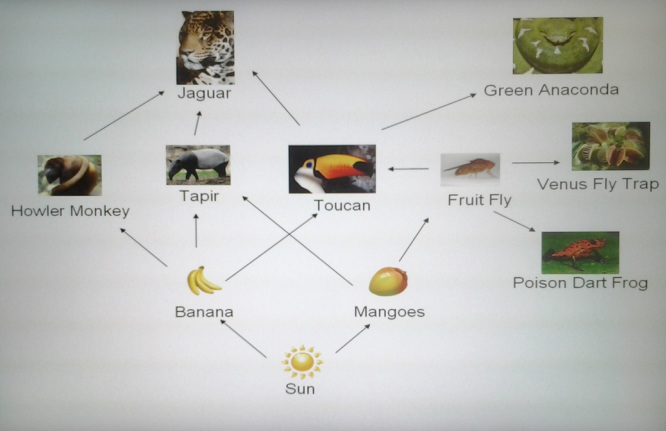Amazon Jungle Food Chain Biology Diagrams Learn about the different parts of the food web in the Amazon rainforest, such as producers, consumers, scavengers and decomposers. See an example of a food web diagram and try an activity to identify the organisms.

Food Chains vs. Food Webs. While a food chain shows one simple path of energy, a food web is more like a big, tangled map showing how many food chains are connected.In a rainforest, animals don't eat just one kind of food. A monkey might eat fruit, leaves, and even insects, and all those different foods link it to many other animals in the rainforest. The Amazon rainforest food chain has different trophic levels that include primary producers, primary consumers and secondary, tertiary and quaternary consumers. Decomposers or detrivores also are part of this food chain. These organisms are bacteria, fungi and certain types of insects that consume leftover waste.

What are some producers in the Amazon rainforest? Biology Diagrams
To understand the Amazon Rainforest Food Web, first read about the Amazon Rainforest Biome using this link.. Then read about the different trophic levels of a typical Food Chain (below). The trophic level is the position that an organism (plant or animal) occupies in a food chain - what it eats, and what eats it.

Learn how energy flows through the rainforest ecosystem when predators eat their prey. See the diversity and complexity of producers, consumers, and decomposers in the Amazon rainforest and other tropical rainforests. Learn how plants, animals, and insects form a complex and diverse food chain and web in the rainforest. Discover the roles of producers, herbivores, omnivores, and carnivores, and how they balance the ecosystem.

Food Chain Of Animals In The Rain Forest Biology Diagrams
Learn about the five components of food chains in the Amazon Rainforest: producers, primary consumers, secondary consumers, decomposers and highest order consumers. See examples of each component and an illustration of an Amazon food web. Primary producers are the base of the food chain, converting sunlight into energy through photosynthesis. In the Amazon rainforest, these producers are mainly plants. Some of the most common Located in South America and bordering nine countries, the Amazon Rainforest has one of the most diverse ecosystems on the planet. Its location on the equator which gives it consistent sun and with a great variety in altitude, the Amazon is home to at least one in ten species that occupy the planet.
